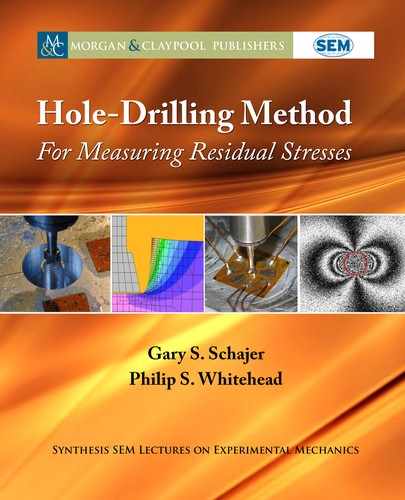
69
C H A P T E R 4
Strain Gauge Technique:
Method Description
“e hole-drilling method can identify in-plane residual stresses near the measured surface of
the workpiece material. e method gives localized measurements that indicate the residual
stresses within the boundaries of the drilled hole.”
ASTM E837 2013 “Standard Test Method for Determining Residual Stresses by the
Hole-drilling Strain-gage Method.”
e strain gauge hole-drilling method involves drilling a small hole at the geometric center of
a specially designed strain gauge rosette bonded to the surface of the specimen. e residual
stresses originally present within the hole are then calculated from the measured strain reliefs.
e measurement procedure includes the following steps.
1. Choose the strain gauge rosette type.
2. Prepare the specimen surface for gauge installation.
3. Install the strain gauge rosette.
4. Connect the rosette to the strain measurement instrumentation.
5. Prepare the drilling machine, setting up, and aligning.
6. Drill a hole at the geometric center of the strain gauge rosette in a series of pre-determined
depth increments and recording of the strain gauge readings after each depth increment.
Measure the diameter of the drilled hole.
7. Present the gauge data (identification and orientation details, relaxed strain data, and hole
diameter) in preparation for the calculation of residual stresses from a data reduction cal-
culation.
e following sections give details of these steps.
..................Content has been hidden....................
You can't read the all page of ebook, please click here login for view all page.
